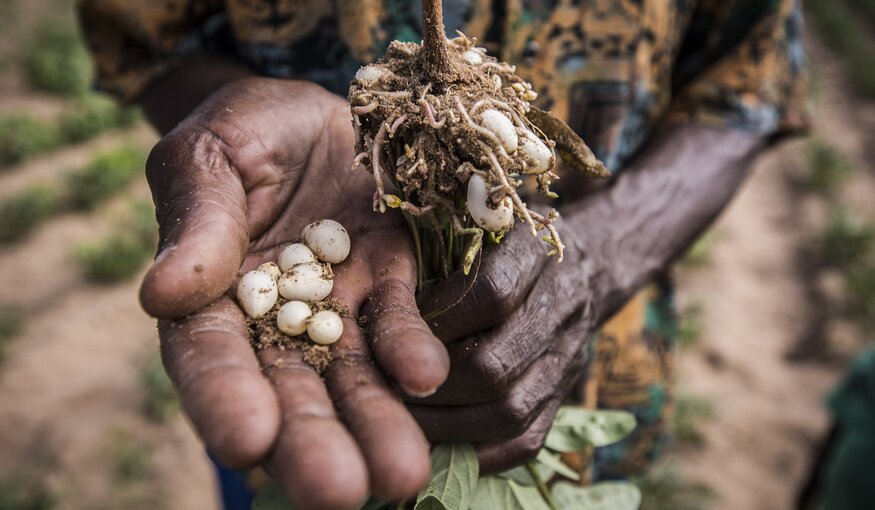Extreme Beans: Conserving Vigna

Bambara groundnuts. Photo: Sacha de Boer/Oxfam Novib
31 May 2023
The Crop Trust facilitated the update of a global strategy to conserve the diversity of Vigna and its wild relatives to help ensure food and nutrition security.
Have you ever eaten koki, Hoppin' John, chè đậu trắng, lǜdòu tángshuǐ, amanattō, or lakhnapuri bhalle? If so, you have the Vigna genus to thank.
There are more than 100 wild species in Vigna, and 10 that are grown for food, including blackgram, adzuki bean, mung bean and cowpea (black-eyed peas). There are some pretty unusual crops among them, like the appropriately named yardlong bean, which produces bean pods that grow to around one yard (90 cm) long! Other Vigna species produce some of the smallest bean seeds. Vigna species are nitrogen-fixing legumes, producing yellow, blue or purple flowers that grow into fruits (pods) containing seeds (beans).
Vigna species are an important food in many parts of the world, especially Asia and Africa. The beans and pods can be eaten fresh or dried and stored. The seeds can be ground into pastes, or milled and made into noodles. The leaves and stalks of several Vigna species can be used as forage for livestock.
It’s a diverse group of crops, but that diversity is now being threatened by many factors, such as climate change, land-use changes and the loss of local varieties when farmers plant new, higher-yielding crops.
Diversity is necessary for breeding new varieties of crops that are resistant to pests and diseases, are able to tolerate harsh environmental conditions and are productive enough to feed the growing global population. That’s why the Crop Trust, together with its partners, and with funding from the German Federal Ministry of Food and Agriculture (BMEL), has developed a Global Strategy for the Conservation and Use of Vigna.
Gathering the evidence base
“A global strategy for the conservation of cowpea, a Vigna crop particularly important in Africa, was published in 2010,” said Peter Giovannini, Global Crop Conservation Strategies, Project Coordinator at the Crop Trust and a co-author of the strategy. “This new strategy aims to update and complement the first one by also including Vigna crops and their wild relatives from the rest of the world, in particular Asia.”
To prepare the new Vigna strategy, scientists at the Crop Trust and the World Vegetable Center searched the major databases to find out what is being conserved already, and what is missing from collections. Next, they surveyed the genebanks that conserve Vigna to learn about the key strengths and weaknesses of their collections, and to get a better understanding of their composition.
Through a literature review, database searches and responses from a genebank survey, the conservation strategy outlines a number of tasks for the coming years. The goal is to expand, document and protect the global Vigna collection, and increase its accessibility.
Growing the global Vigna collection
A key recommendation is to grow the global collection by filling some remaining gaps that were identified. This includes farmers’ local varieties from under-represented regions of the world and a number of threatened and endemic wild species.
All existing collections should be properly backed-up at another genebank for safety, and ideally at the Svalbard Global Seed Vault as well.
Helping genebanks run more efficiently and effectively
At present, the various genebanks interested in Vigna collect different information about their conserved diversity, in different ways. “The strategy recommends developing a standardized, comprehensive list of basic descriptors for Vigna,” said Ramakrishnan M. Nair, a legume breeder at the World Vegetable Center and the lead author of the study. “This will streamline collecting data on the morphology of different samples and make the exchange of information much easier. We’ll be able to work together better.”
But basic information is not enough. Analyses of the genotypes of Vigna varieties, especially newly collected ones, will identify unique material. Agronomic screening will identify which samples have useful traits, like drought tolerance, disease resistance and high nutrient content.
These additional data, along with key basic descriptors for each accession, should be systematically cataloged in a well-established and readily accessible database.
Another recommendation is for more training of genebank staff in germplasm conservation and management. As well as improving skills and expertise, this will improve access to germplasm in accordance with international policies.
The strategy aims to promote not only the conservation of Vigna, but also its use. Accurate information in searchable databases will increase the use of collections because users can more easily select materials with specific characteristics. The development of effective regeneration protocols will ensure that there are enough high-quality Vigna seeds to share in the first place.
In addition, genebanks should produce core and mini-core collections that represent in relatively few samples as much as possible of the full range of conserved diversity, and that can promote the use of species that have been hitherto neglected.
“Researchers and breeders can use these species and collections to dissect important traits and breed desirable characteristics into new cultivars. But genebanks need to make their job as easy as possible,” said Ramakrishnan.
Ensuring long-term funding for conservation
All of these initiatives require funding, so the strategy recommends a long-term global funding strategy for the collection, conservation and distribution of Vigna seeds. The strategy also recommends establishing a strong international platform to assist small genebanks by providing financial support and leveraging the know-how and experience of larger ones. Smaller genebanks must be fully integrated into an inclusive global system of conservation.
Categories: Global Crop Conservation Strategies, Cowpea
About the Global Crop Conservation Strategy project
The development of this Global Crop Conservation Strategy was funded by the German Federal Ministry of Food and Agriculture (BMEL) as part of a three-year project led by the Crop Trust: “Breathing New Life into the Global Crop Conservation Strategies: Providing an Evidence Base for the Global System of Ex situ Conservation of Crop Diversity.”
